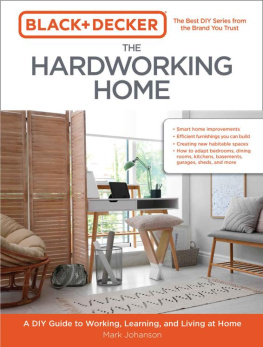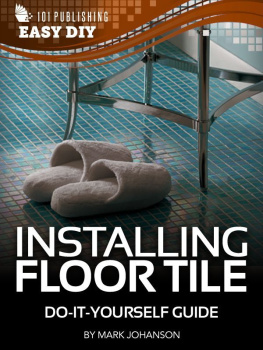Cover
THE
HARDWORKING
HOME
A DIY Guide to Working, Learning,
and Living at Home
Mark Johanson
Contents
Introduction
T he movement toward living remotely and self-sufficiently was growing steadily long before the coronavirus lit a bonfire beneath it. Even as those flames die down, it is clear that we are now confronting what is so often described as a new normal. The entire dynamic of social interaction has been permanently altered and the fallout is here to stay. The bottom line is that as we proceed into the future, we will be spending more time in our houses, condos, and apartments, and the impulse has never been stronger to make our spaces more comfortable, flexible, and hard working for everyone who lives, learns, and works there.
From home offices to home schooling to home entertainment, todays households have necessarily become functional microcosms of society. Before the pandemic, somewhere between 5 and 20 percent of full-time employees worked remotely from home. At the height of the outbreak, more than half did. And, even as the dust settles, it is estimated that at least a quarter of us will be performing our jobs from offices in our homes. Distance learning also will endure as an important educational tool. While we ease back into less restrictive social distancing guidelines, it nevertheless makes sense to create a fun, vibrant atmosphere for entertaining ourselves and our guests within the safe confines of our homes. The goal, in short, is to improve your environment so you do not become someone who says, I dont work from home; I live at work.
BLACK+DECKER The Hardworking Home is fundamentally a project book that presents a wide range of achievable home improvements to help you upgrade (and work with) your home to better meet our shifting world. Some of the projects are quite simple and others require a little more DIY experience. But the overriding commonality is that they are curated with the forward-looking filter of making our lives better, more efficient, and more satisfying in the new world landscape. Tips, hints, hacks, and full-blown DIY projects; these are hardworking improvements meant to last. So, take your time and take care when you workit looks like this will be a long ride.
What Makes a Hardworking Home?
A ll homes are hardworking, of course. Shelter, warmth, a place to cook and eat, bathrooms, and spots for relaxation: the list of valuable contributions of any house is long. Plus, they are where we keep our stuff. But most houses can work harder if the homeowner uses some creativity and determination. Even a 5,000-square-foot mini-mansion can be made more efficient and gain functionality with some planning. Why does it matter? Because now, more than any time in recent history, our homes are the engines of our economy, if not the locales that support how we make our livings. Like any business, we find ourselves scrambling for ways to make our living spaces ever more efficient and profitable.
A hardworking home is one that has been put under a microscope and evaluated with a strong dose of reality and practicality. Is every room in your house pulling its weight? Or are there some slackers that youve become accustomed to when, if you examine the room closely, youll have to admit that the space is being underused if not wasted? If, for example, you have a dedicated gift-wrapping room, you really need to think about your priorities and utilization (unless gift-wrapping is your business).
The journey to a more productive home begins with a clear-eyed evaluation: a room-by-room examination of how you use each area counterposed with what you want your home to provide.
As far as usage, the home office is an increasingly necessary starting point, but your home potentially can support your lifestyle in many other ways: a craft area where you can pursue your avocation in peace and make a big mess in the process; a place for the kids to hang out and study; personal space or the rec room of your dreams; more storage; a home theater; a mother-in-law apartment; or a welcoming guest room. The only limit to your list is your imagination. Helping you transform underused space into something functional is the main objective of this book. And perhaps the best news is that youll learn to do the necessary work yourself.
A bit of remodeling can go a long way if you want to expand your usable living space without adding onto your house.
 TIPS FOR WORKING SAFELY
TIPS FOR WORKING SAFELY
Wear appropriate clothing and safety gear.
Personal safety is perhaps the most critical element of any home improvement project. Here are some safety considerations to keep in mind.
- Know your tools and their safety features, including blade guards and dust collection bags.
- Keep the work environment clean and neat. Get rid of debris and packaging right away.
- Be sure to have adequate ventilation, especially when working with paints, adhesives, and solvents.
- Control dust through ventilation and by masking off the work area from the rest of the house when possible.
- Keep a well-stocked first aid kit close at hand, as well as a telephone for making emergency calls.
- Do not use power tools in wet or damp conditions.
- If the electrical circuits you are using do not have ground-fault (GFCI) protection, use an extension cord that has a GFCI adapter.
- Always wear sensible clothing with long sleeves and pants that dont fit too loosely. Wear safety apparel, including eye protection, work gloves, and ear protection.
Planning and Preparation
Any project you undertake will benefit from research, careful thought, and good planning. This is especially true when your plan involves making changes, both structural and nonstructural, to your house. Your ideas and goals need to make sense and conform to home standards and codes, and your implementation should follow logical steps that keep you on schedule and budget.
Even if you own your home, there are definite dos and donts to be aware of as you work out how to put your ideas into effect. Structural changes or working on wiring or plumbing likely will require a building permit from your local building department. To obtain this, you will need to submit a plan and/or plan drawing that conforms to the building codes in force in your municipality. Youll also need to pay a fee, usually based on the value of the remodeling work. And some, but not all, permits require on-site inspections and approval at key points in the project. The best strategy is to involve your building department from the start. Tell them what you are planning and ask which codes are important to be aware of as you go. Most inspectors appreciate the effort as getting things right from the start makes their job easier, too.




















 TIPS FOR WORKING SAFELY
TIPS FOR WORKING SAFELY